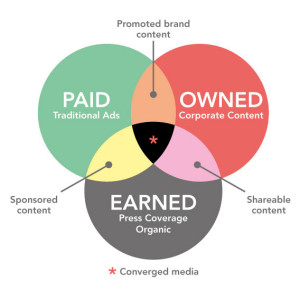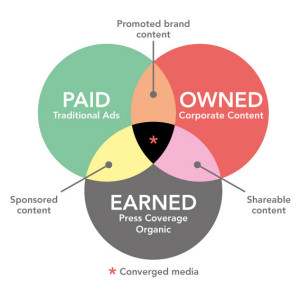As a new year dawns, it is time to look forward to the year ahead. To kick off the year, we are highlighting some of the marketing trends we predict for 2015 and how you can incorporate them into your plans.
1. Converged media
As the lines become increasingly blurred between paid, earned and owned media, a company’s content strategy becomes more complex. The best content strategies in 2015 will acknowledge the convergence of different types of media as an opportunity to develop plans that combine the strengths of all the media channels. Earned and owned media continue to play an important role in establishing your company as a thought-leader, while advertising helps build your brand awareness. However, a much larger opportunity exists when you can integrate earned media conversations into both paid and owned media. For example, you should be considering using the power and reach of paid media to highlight positive customer feedback about your brand. Converged media is how you integrate owned, earned, and paid media to support your business goals and quickly position your organisation as an industry leader.
If you haven’t developed your content strategy, take a look at the graphic below and use this as a start point to address the converged media landscape*.
It’s likely that there are strategic opportunities to expand the reach of your content that you haven’t considered. For example, you could repurpose your latest whitepaper into a trade article or pay publishers to promote your content as native advertising. You could then create a short blog summarising that article, either to host on your site or as a LinkedIn post. That post could go on to be promoted as a sponsored post so that it is seen by relevant people outside of your immediate network and perhaps even shared in a number of relevant LinkedIn groups to extend your reach even further.
And of course, this is just one piece of content, shared via a specific set of channels. Can you do this to promote your next infographic, maybe using Twitter and Facebook? Or repurpose your latest whitepaper as a blog series, promoting them via your email newsletter and even pitching them as trade articles.
2. Mobile marketing
Early in 2014, internet usage on mobile devices exceeded PC usage for the first time. Moving forward you are going to have to put mobile marketing at the forefront of your plans and identify how to leverage the technology to develop experiences that will address the needs of your customers. It is vital when planning every piece of content to consider what will also work effectively on a small mobile screen and how to convey information in a concise yet meaningful way.
If you have not developed a mobile marketing strategy, a good start point is to investigate
1. How user-friendly your website is on mobile devices
2. What software is available to help you build a mobile version of your current site
A first step may be a move towards adopting a scrolling-based website (with most of your key content housed on a single, scrollable page) over a traditional clicking-based one, which leads to an improved mobile experience with reduced page loading times. You might also look to experiment with creating html-based content rather than relying on traditional formats such as PDFs, as the latter are often not easy to browse and read on a small screen.
When developing new web content, especially new websites, consider building with responsive design in mind so that your pages will automatically reflow (and images resize) depending on what screen size the visitor is using. You can also infuse this ethos into the design of other html-based content e.g. emailers, but be aware that different email clients interpret emails in different ways, so testing your emails using tools such as Litmus is essential for making sure they'll look great on most devices and in all the popular email clients (Gmail, Outlook etc).
3. Hyper-personalisation
Over the past decade we have seen a huge shift towards personalised marketing communications, however 2015 is set to be the year of hyper-personalisation. Nowadays customers expect to be treated as individuals. Email continues to lead the way in personalised marketing and research by Aberdeen Group shows that personalised emails improve click-through rates by 14% and conversion rates by 10%. Leads that are nurtured with targeted content produce a 20% increase in sales opportunities according to DemandGen. In addition, research has demonstrated that 74% of online consumers get frustrated when website content (e.g. special offers, ads and promotions) appears to have nothing to do with their interests.
The factors holding many companies back from hyper-personalisation are strategic (e.g. defining the ways personalisation would be most useful) and technological (e.g. needing to move to new email marketing/content management/marketing automation software). However, businesses that are not looking into how they can create unique experiences for each prospective and existing customer will soon fall behind the competition, especially if they currently serve ‘large markets’ that have not been more clearly segmented based on true customer interests.
Your first steps for hyper-personalisation should be
1. Market research to ascertain the type of content that customers and prospects want to receive and the ways in which they wish to receive it
2. A clearer and deeper segmentation of your customers and prospects so you can target specific subsets of people with more relevant offers and content.
3. To get a better understanding of how existing software and content optimisation systems could allow you to personalise your website’s content for each visitor and tailor your email marketing campaigns to each individual. Certain email marketing software and content optimisation systems automate the process to make administration easier and more efficient.
4. Agile marketing
The dawn of the social media age has brought about the need for agile marketing. Channels such as Twitter, Facebook and LinkedIn are pushing us to react in real-time to events and conversations among our customers. It is vital that you are geared-up for real-time, ‘always-on’ marketing.
A good starting point is to develop a social media policy for your company and identify and appoint your social media spokespeople. They do not need to be the most technically-savvy people in the organisation but they must have the diplomacy, maturity and knowledge to monitor, develop and verify appropriate content and responses. They should be a collection of experts who are trusted to represent your organisation and its brands and they must be prepared to be agile, collaborative and responsive.
You could also explore the benefits offered by technology for allowing you to effectively monitor and respond to online conversations in a timely manner.
5. Visual marketing
Already big in 2014, the appeal of visual marketing will rise even higher in 2015. While channels such as YouTube, Instagram, Pinterest, Tumblr and Vine will play a greater role in content marketing strategies, so too will individual pieces of content like infographics and memes. According to 3M Corporation and Zabisco, 90% of information transmitted to the brain is visual and visuals are processed 60,000 times faster in the brain than text. As a result, information is better communicated visually. Visual content is also social media-friendly and easily shared and digested. If your marketing plans don’t consider visual marketing elements, you will lose out on engaging and nurturing your customers, prospects and communities to the competition.
A good start would be to look at your brand messaging and think about how you could transform it into visual storytelling using video, infographics and memes. Visual stories crafted for marketing purposes should send a clear message about the brand to its consumer communities and help to define it in a crowded marketplace.
This is also another area where content repurposing can maximise the ROI of the content you create. For example, you could adapt your latest whitepaper into an infographic. In many cases, the research we conduct when drafting whitepapers is strong material for creating infographics. In addition, if you’ve drafted a written piece with a strong central story arc then it could be possible to identify its core messaging and reformulate it into a visual form such as an infographic, animation or scrolling web-story.
Stay up to date on the latest trends - subscribe to our monthly enewsletter!
* There are a number of converged media schematics on the web - we're thankful to all those that inspired ours.


